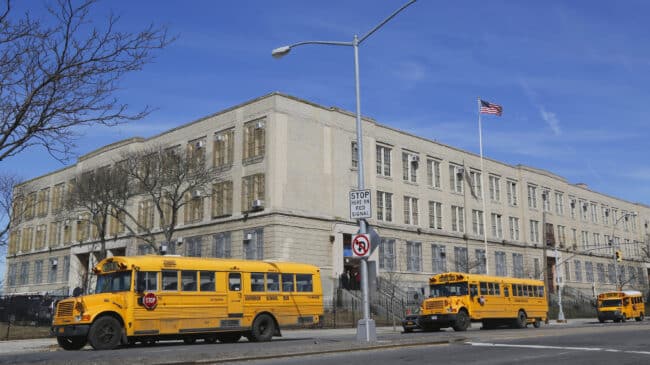Since 2020, K-12 enrollment in New York City has dropped by 9.5% with some 30,000 fewer students projected to walk classroom halls this school year.
A downward trend started long before stay-at-home orders and other COV ID-19 pandemic-related measures prompted more parents to seek alternatives to public schools. New York City’s Independent Budget Office began reporting public school enrollment declines in the 2015-16 school year. From 2002-to-2020, New York state experienced the nation’s sharpest loss, losing 11% of public school students over two decades.
Despite these well-reported enrollment figures, some New York City officials said they were shocked to see their budgets taper for the 2022-23 school year. Politico reported on the New York City Council backtracking after it initially passed a budget that included a $215 million reduction in education spending:
But the Council is now requesting that the Adams administration reverse the very cuts it voted to approve — cuts that were included in the preliminary budget in February — as well as look into allocating federal stimulus dollars directly to schools, POLITICO’s Madina Touré reports.
Council members also called on the administration to update the Fair Student Funding formula, which was created in 2007 as serves as the primary source of funding for individual schools’ budgets.
“That distinction is critical, because the fiscal year 2023 city budget actually invested over $700 million more in city funds for DOE than the previous budget, bringing total city funds spent on DOE to the highest level that our city’s history has ever seen. Yet some of our individual and local schools are facing budgets that are drastic and different for the next school year,” claimed New York City Council Speaker, Adrienne Adams (D-Queens), who voted for the budget.
Common sense budgeting and education finance policy suggest that public schools serving fewer students would be receiving less taxpayer money than they did when they had tens of thousands more students. But that’s not the way New York has treated K-12 education funding in recent years.
New York’s inflation-adjusted education spending increased by $26.4 billion between 2002 and 2020. The state now spends a staggering $30,723 per student—the highest per pupil spending in the country.
Along with education expenditures failing to connect with the reality of declining student enrollment, unfortunately, New York also has little to show regarding student achievement improvements.
The National Center for Education Statistics found New York eighth graders weren’t exceeding national reading or math scores averages in 2019, despite the state’s exorbitantly above-average spending. In 2019, only 34% of New York’s eighth-grade students performed at or above the National Assessment of Educational Progress proficiency level for math, 32% of eighth graders were at or above proficient in reading, and 30% were at or above proficient in science.
When reviewing scores of students from low-income families, in particular, states such as Florida and Indiana outperformed New York, all while spending significantly fewer tax dollars. For comparison, Florida spent $11,526 per pupil compared to New York’s $30,723 per student.
But Florida, despite spending just over one-third of what New York spends per student, got similar student test results. In 2019, 31% of Florida eighth-grade students performed at or above the National Assessment of Educational Progress proficiency level for math, and 34% of Florida’s eighth graders were at or above proficient in reading, and 33% were at or above proficient in science.
The Shanker Institute, a think tank “endowed by the American Federation of Teachers and named in honor of its late president,” claims there is a direct link between higher public spending on education and improved student achievement. Nearly every New York school district not only met the Shanker Institute’s education budget targets, but most are also spending in excess of the group’s recommendations. Thus, according to Shanker’s research, New York school districts should be performing well above average on national math and reading exams. In reality, the state continues to perform no better than the national average.
New York’s historic public school system price tag can be traced not only to maintaining the country’s highest average teacher salary and increasing pension benefit costs but also to personnel hiring outside of the classroom. The number of school administrators in New York schools, for example, grew by 64% per pupil over two decades, exceeding the nationwide average. Over this same period, New York’s total personnel benefit spending increased by 141% per-pupil, the fifth highest rate in the United States. The overwhelming costs of all American public school systems stem directly from personnel salaries and benefits.
Crystal Peoples-Stokes (D-Buffalo), majority leader of the New York State Assembly, asked the right question during a committee hearing:
“[We are] sending far too many students to college that are not prepared to be in college and that is not a very good return on the investment that we put in for K-12. I’m appreciative that [the Department of Education] will get access to additional positions, although I hope those positions end up having some real concerted focus on making sure that foundational education is provided for everyone who attends school in the state of New York. Given that does not happen, how are we ever going to hold someone responsible that every year we spend more but every year we’re not getting more?”
New York’s education spending and public school system are not producing the desired results for students, so more parents are seeking alternatives. Public charter schools in New York City have seen a 9% rise in enrollees over the past two years. Today, one in every four black students in New York City is being served by a public charter school. Interestingly, these alternative schooling environments are a desirable option for New York’s families despite charter schools receiving an estimated 19% less per student in funding than their traditional public school counterparts, according to research from the School Choice Demonstration Project at the University of Arkansas.
Regrettably, the state legislature imposed a ban that prevents any additional charter schools from opening.
New York’s enrollment figures are dropping while student test scores are, at best, stagnating. Policymakers and community leaders should be looking for ways to better serve students through a more market-driven and student-centered approach.

